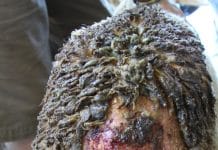Rabies is a unique disease in many ways. The main reason for controlling it is because it is zoonotic – it can be transmitted from animals to humans – and it is nearly always fatal. Rabies is truly one of the most terrifying diseases a human can contract, yet it is almost 100% preventable.
It is estimated that worldwide approximately 70 000 humans die of the disease annually. Although this might not seem like a large number compared to some other diseases, it is still staggering if you consider that it is almost entirely preventable. This is largely because people are still fairly ignorant about rabies.
Understanding rabies

It is a legal requirement that will not only ensure
your animals’ wellbeing, but that will also protect
your family.
Rabies is caused by a virus to which all mammals are susceptible, and which is mainly transmitted via the bite of an infected animal. The disease can also be transmitted when the saliva of an infected animal comes into contact with the mucous membranes of other mammals or enter the body through a break in the skin.
Another unusual characteristic of the virus is that the nervous system carries it through the body to the brain, where it causes the symptoms that result in the death of the animal or person. Because of this, incubation periods vary greatly and can range from a few days to a few years after being exposed to the virus. The average incubation period, however, is six months.
There are two recognised cycles: The urban cycle, in which dogs are the main carriers of the virus, and the sylvatic cycle, in which wildlife transmit the disease. Both these cycles are present in South Africa.
Disease symptoms
Rabies symptoms can vary widely. The typical picture that comes to mind is that of an aggressive dog foaming at the mouth. While this is a classic symptom, it is not always the case.
Rabies can lead to paralysis as well as other neurological changes in dogs. Generally, animals with rabies will exhibit behavioural changes. In cattle, for example, it often causes continuous bellowing and excessive salivation, which leads farmers to think that the animal has something stuck in its throat. Wildlife often lose their natural fear of humans and can appear tame.
Control measures
Prevention: In South Africa it is compulsory to vaccinate all dogs and cats with a registered vaccine against rabies at the age of three months. This must be followed by a second vaccination within twelve months after the first vaccination, but no sooner than 30 days after the first one. After that, dogs and cats must be vaccinated every three years.
Puppies and kittens younger than three months may be vaccinated if there is a high risk, followed by a second vaccination at three months. Afterwards, the required prescription needs to be followed.
Although it is not compulsory under the Animal Diseases Regulations to vaccinate other animals as a preventative measure, it should be considered in areas in which there is a high incidence of rabies. Vaccinations must also be considered for valuable animals.
Suspected outbreaks: It is vital to notify the responsible state veterinarian immediately if there are any suspected cases of rabies.
The Regulations stipulate that the suspected animal must either be quarantined or destroyed. If it is possible to quarantine the animal until the state veterinarian can examine it, this route should be followed. If the animal poses a danger to other animals or humans, or if there is a high risk of the animal escaping, it must be destroyed and the carcass kept until state veterinary officials can inspect it.
To confirm the presence of rabies, it is vital to keep the brain of the animal intact; if it is necessary to shoot the animal, a headshot should be avoided. Gloves must be worn when handling the carcass and it must be kept in a secure place until state veterinary officials can take control of it.
Contact and infected animals
Contact animals must be quarantined until the state veterinarian has decided if they should be destroyed, or immunised and quarantined for a longer period. The quarantine period depends on the circumstances and is determined by the responsible state veterinarian. Due to the long incubation period, however, the quarantine period can extend over several months.
Any person who has come into contact with a suspected or confirmed case of animal rabies must inform his or her medical doctor as well as the relevant Department of Health.
Contact animals must be immunised by or under the supervision of a veterinarian or official. The quarantine facilities must be of such a nature that other susceptible animals cannot come into contact with the quarantined animals, and any escape routes must be secured. Direct human contact must be avoided.
Among other things, equipment and bedding used for such animals cannot be used for other animals and must be properly disinfected or destroyed, depending on the relevant state veterinarian’s instructions.
Potential human contact
Human contact with suspected cases does not fall within the scope of the Animal Diseases Act, 1984 (Act 35 of 1984), but within that of the National Health Act, 2003 (Act 61 of 2003). In terms of the Health Regulations, rabies in humans is a notifiable disease and must be reported.
Any person who has come into contact with a suspected or confirmed case of animal rabies must inform his or her medical doctor as well as the relevant Department of Health.
If there is a real concern, prophylactic treatment must be administered immediately. Unfortunately, some doctors are not always familiar with the disease and are often reluctant to start prophylactic treatment. In such cases, the National Institute for Communicable Diseases (NICD) can be contacted for assistance (the hotline number is 072 621 3805). It can mean the difference between life and death.
In conclusion
Although rabies is a terrible disease, it is preventable. South Africans can all play a role in its prevention and potential eradication by following the requirements set out in the Animal Diseases Act, as well as ensuring that all dogs and cats are properly immunised. Knowing what the disease entails can help prevent its spread, and appropriate actions taken timeously can prevent tragedy. – Dr Trudie Prinsloo, director of Legalvet Services
For more information, contact Dr Trudie Prinsloo, director of Legalvet Services, on 021 911 2820 or 082 560 1359, or email trudie@legalvetservices.co.za.






